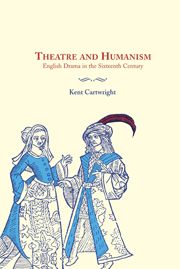Book contents
- Frontmatter
- Contents
- Acknowledgments
- Introduction
- 1 The humanism of acting: John Heywood's The Foure PP
- 2 Wit and Science and the dramaturgy of learning
- 3 Playing against type: Gammer Gurton's Needle
- 4 Time, tyranny, and suspense in political drama of the 1560s
- 5 Humanism and the dramatizing of women
- 6 The confusions of Gallathea: John Lyly as popular dramatist
- 7 Bearing witness to Tamburlaine, Part 1
- 8 Robert Green's Friar Bacon and Friar Bungay: the commonwealth of the present moment
- Afterword
- Notes
- Index
3 - Playing against type: Gammer Gurton's Needle
Published online by Cambridge University Press: 22 September 2009
- Frontmatter
- Contents
- Acknowledgments
- Introduction
- 1 The humanism of acting: John Heywood's The Foure PP
- 2 Wit and Science and the dramaturgy of learning
- 3 Playing against type: Gammer Gurton's Needle
- 4 Time, tyranny, and suspense in political drama of the 1560s
- 5 Humanism and the dramatizing of women
- 6 The confusions of Gallathea: John Lyly as popular dramatist
- 7 Bearing witness to Tamburlaine, Part 1
- 8 Robert Green's Friar Bacon and Friar Bungay: the commonwealth of the present moment
- Afterword
- Notes
- Index
Summary
“Prove your invention! Write a Terentian comedy about a trifle!” Thus, scholars sometimes imagine, “Mr. S. M[aster] of Art” came to write Gammer Gurton's Needle (c. 1553), rising to a challenge by a fellow teacher at Christ's College, Cambridge. If Gammer Gurton's Needle was born in the admiration of Terence, all schoolboys have not felt that reverence, as a student of a later generation avers: “Terence, this is stupid stuff!” With Terence as explicated by Donatus, and Terence and Donatus as explicated by Melanchthon, thrummed and drummed into his brain, a young Tudor grammarian might have wondered: “Is life really like classical comedy?” To link Tudor experience and ancient art, Mr. S. infuses Terentian structure with adolescent anxiety, confusion about agency, and satire on academic rationalism: in humanist dramaturgy a formalist model becomes saturated with playful contradictions. Against the critique that humanist plays drift toward intellectualism, while popular morality drama accounts for early theatre's energy, immediacy, and sense of game, Gammer Gurton's Needle reveals humanist playmaking's under-appreciated theatrical vitality and inventiveness.
One virtue of Gammer Gurton's Needle is its open-endedness, a feeling of unpredictable possibility, even a burgeoning sense of emotional life and magic – qualities manifested in its impish sabotagings of form, expectation, logic, and stereotype. In Wit and Science, as we have seen, humanist drama develops its metaphoric richness and emotional voltage to advance rhetorical ends; in Gammer Gurton's Needle, didacticism now turns playfully ironic as the play explores theatre's emotional life.
- Type
- Chapter
- Information
- Theatre and HumanismEnglish Drama in the Sixteenth Century, pp. 75 - 99Publisher: Cambridge University PressPrint publication year: 1999



